Choosing the right Employee Assistance Programme (EAP) is no easy task. With so many providers offering varying levels of care and services, how can you be sure your team is getting the support they need?
Employees expect more than just basic mental health services—they want a holistic approach to preventative care that helps them thrive. In fact, 70% of employees say they’d consider leaving their jobs for better health and wellbeing benefits. To meet these rising expectations, organisations need to carefully compare EAP providers to make sure they deliver real value and meaningful outcomes.
This 10-step checklist is designed to guide you through the process. From scope of care to utilisation rates and ROI, we’ll help you evaluate key factors to make an informed choice and support your team effectively.
Step one – Scope of care
Key question: Is it more than a mental health platform?
28% of UK workers crave greater workplace health and wellbeing support from their employer that goes beyond employee mental health services. To perform at their best, many employees want their employers to provide ongoing, preventative care and medical and safety benefits, too.
Without them, they’re waiting longer for urgent healthcare appointments, being turned away when their case is too complex, and delaying vital healthcare due to affordability. Factor in the UK’s cost of living crisis and periods of civil unrest, and it’s easy to see why many employees struggle to concentrate or achieve results at work.
Some leaders argue it’s not their responsibility to provide support after work hours. But offering comprehensive 24/7 support directly impacts the organisation’s bottom line.
Still, pinpointing exactly what employees need from their EAP is challenging. In a survey of 500 UK HR directors:
- 48% of companies experience poor uptake of employee benefits because their workers “don’t seem interested” in them
- 62% believe their benefits “don’t address what people really need”
- 32% say certain employee benefits require too much effort for employees
Insider tip
Ask your employees which wellbeing benefits they would value the most. Not everyone needs counselling, yoga, or a gym pass.
Example checklist for scope of care
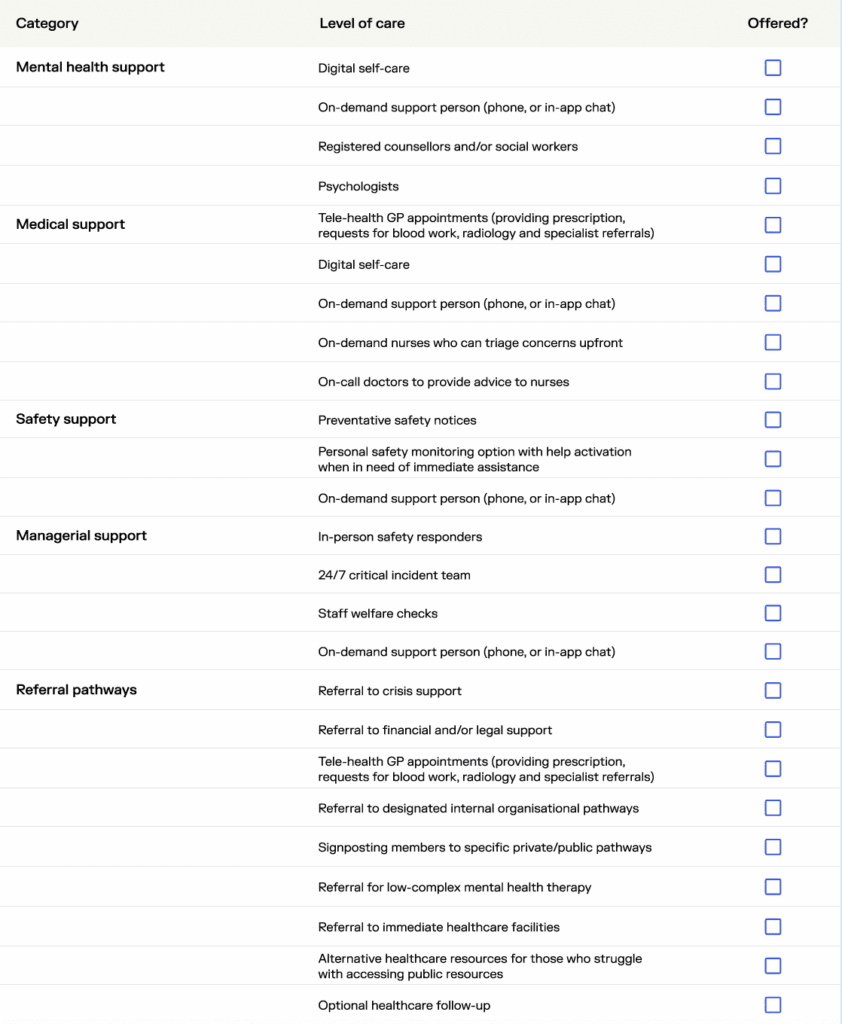
Step two – Hours of care
Key question: Can your people access care when they need it?
Most EAPs offer after-hours care, but the level of care varies, especially if it’s not related to crisis management.
It’s essential to understand typical options, clarify expectations, and establish clear service level agreements (SLAs). By doing so, you’ll gain confidence in your provider’s capabilities and peace of mind that your people can access the care they need whenever they need it.
Did you know?
- Most people reach out for support after business hours.
- An on-demand chat could prevent an employee from needing sick leave.
- A five-hour wait at the emergency room may feel impossible for a parent with young children.
- The longer people are unwell, the worse their primary (and secondary) condition can become.
Insider tip
Nothing beats a real-life test. Pilot your provider’s wide range of services at various hours of the day and night.
Example options for hours of care
| Services offered | Example A | Example B | Example C | Example D | Sonder |
| Immediate access to a support person | n/a Booking form only | 9am-5pm5 days 5pm-9pm appointment setting only | 9am-9pm5 days 9pm-12am crisis-only assistance | 24 hours5 days | 24 hours7 days |
| Immediate access to a nurse or doctor | n/a | n/a | n/a | 9am-5pm5 days | 24 hours7 days |
| Immediate access to a safety team | n/a | n/a | n/a | n/a | 24 hours7 days |
| Wait time for a counsellor | 10-14 days | 7-10 days | 5-7 days | 2-5 days | 0-2 days |
| Wait time for a psychologist | n/a | n/a | 7-14 days | 3-7 days | 0-2 days |
*Disclaimer: Typical examples only. Times may vary depending on SLAs. May not apply to remote or regional areas.
Step three – Critical incidents
Key question: What support is offered, and does it follow best practice?
Critical incidents may occur either inside or outside of work, causing trauma to your team members.
Examples of work-related critical incidents include customer violence, armed robbery, attempted suicide in the workplace, and natural disasters. A death of an employee would also be considered a critical incident.
Organisations might not be able to predict or prevent critical incidents, but they can put services in place to connect with their people, confirm they’re in a safe space, keep them updated as events unfold, and ensure they can easily access post-event care.
Insider tip
Not everyone is ready for support immediately after an incident. Be sure your employees know how to reach out for post-event support in the days, weeks, and months to come.
Did you know?
Many traditional EAPs fall short because their range of services is only available between 9 am and 5 pm – a time when most people aren’t actually seeking help. 73% of Sonder support cases start outside of business hours, based on data collected between October 2023 and October 2024.
Example options for critical incident support
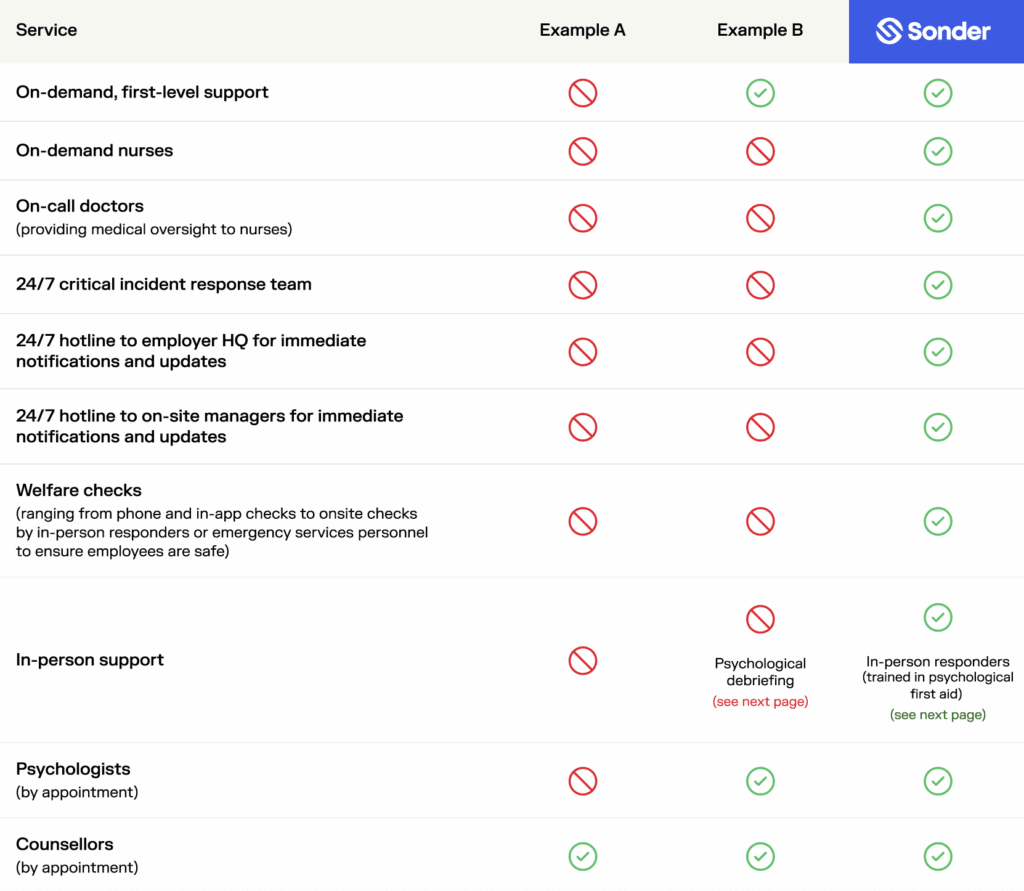
Post-incident best practice
Can psychological debriefing cause harm?
For years, well-intentioned employers keen to exercise their duty of care have paid expensive rates for an onsite psychologist to support employees after traumatic events.
Unfortunately, this approach may have jeopardised employee health and increased organisational risk.Evidence strongly suggests that psychological debriefing does more harm than good — most employees won’t need it.
Psychological first aid (PFA)
Instead, PFA is the best practice, modern approach to critical incidents and disasters. Its premise is that people are naturally resilient and, in most cases, can recover naturally from trauma.
PFA describes a “humane, supportive response to a fellow human being who is suffering and who may need support.”
It aims to reduce initial distress, meet current needs, promote flexible coping, and encourage adjustment. It can be delivered by colleagues and/or managers.
Five principles of psychological first aid (PFA)
- Ensuring safety
- Promoting calm
- Encouraging self-efficacy
- Creating connectedness
- Instilling hope
Step four – Accreditations and qualifications
Key question: How can these affect the quality of care?
Different EAP providers use different terminology. It’s important to understand what these terms mean because they can make a big difference to their quality of care.
Member associations
EAP providers may join a member association, but they’re not required to. For example, in the UK, the Employee Assistance Professionals Association, orEAPA, aims to promote high standards of practice for EAPs.
Healthcare accreditations
Some modern providers have obtained healthcare accreditation, too. For example, Sonder, an EAP alternative, is accredited by the UK Nursing and Midwifery Council. Additionally, the independent regulator of health and adult social care services in England is the Care Quality Commission (CQC.)
Did you know?
- EAP member associations cannot enforce service quality or clinical governance. But they can share knowledge and best practices.
- Providers can seek healthcare accreditation if they pass a rigorous external audit process and agree to annual audits and an ongoing quality assessment and improvement program.
- Strict adherence to privacy and confidentiality is assured when providers are accredited by healthcare councils or regulators, who require external audits of clinical governance.
Qualifications checklist
Protected job titles
Some professionals have protected job titles with qualification checks. To legally use their job title, they must fulfill certain criteria (education, qualifications, and/or experience) and be registered by their relevant government authority or professions council.
- Psychologist: Must hold a recognised psychology degree and complete an accredited postgraduate qualification in their specialty. They’re required to register with the Health and Care Professions Council (HCPC) to use titles such as “Clinical Psychologist” or “Counselling Psychologist.”
- Social Worker: Must be registered with Social Work England to practise. This ensures they meet the required professional standards for education and conduct.
- Psychiatrist: As medical doctors, psychiatrists must complete a medical degree and specialist postgraduate training in psychiatry. They are regulated by the General Medical Council (GMC).
- Nurse: Nurses must be registered with the Nursing and Midwifery Council (NMC) and meet specific educational and practical standards to maintain their professional status.
Insider tip
You can check the current registration status of individual health professionals by searching for their names online on the relevant national registers.
Qualifications checklist
Non-protected job titles
Other professionals have unprotected job titles and no official qualification checks. This means they can join an industry association voluntarily to stay updated on best practices, but their qualifications, skills, and experience vary considerably.
- Counsellor: This title is not legally protected in the UK, but many reputable counsellors register with professional organisations like the British Association for Counselling and Psychotherapy (BACP) or the UK Council for Psychotherapy (UKCP). Membership ensures adherence to professional standards and ethical guidelines.
- Therapist: A person who typically has a bachelor’s degree or postgraduate qualification in counselling, psychology, or social work. They may have completed specialised training and supervision with a dedicated training provider.
- Coach: A person who has received some training and may or may not hold membership to an association relevant to their area of practice.
Step five – Digital self-help
Key question: Should a digital platform supplement or replace human support?
Many organisations now offer digital self-help tools as part of their employee wellbeing benefits. Research shows these online tools are equally as effective as face-to-face therapy sessions for some people with mental health issues.
These solutions can deliver easy wins with minimal cost and effort. However, they can also bring drawbacks:
Digital self-help tools that replace EAPs can increase organisational risk. Some experts fear vulnerable users could be harmed if they remove the expertise of human triage, support, and follow-up.
Online resources that supplement EAPs can add another layer to a complex support ecosystem that employees already find hard to navigate – unless they provide a single entry point for all wellbeing support services.
Insider tip
Most EAP providers now offer digital self-help tools, but the offerings can vary greatly. Ask if you can try before you buy.
Did you know?
- Self-help tools risk user drop-off unless there is human support and ongoing follow-up.
- Self-help apps may waste people’s time and cause delays in receiving effective care.
- Predefined self-help categories neglect that many mental wellbeing issues are complex and multilayered.
- Self-help tools usually lack the oversight of medical and mental health professionals, or clinical governance.
- Standalone digital interventions ignore decades of research about the importance of social support and may further isolate individuals who need human connection the most.
Example options for digital self-help
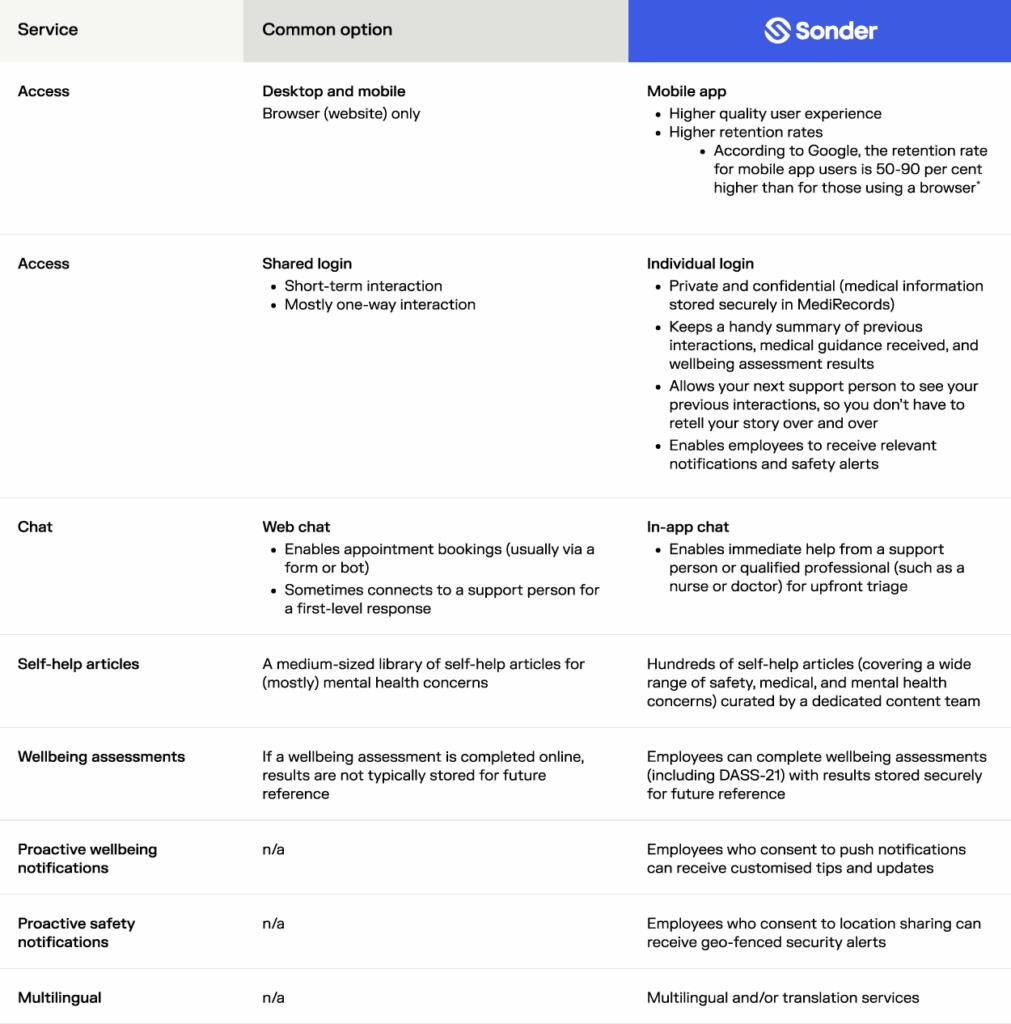
Step six – Utilisation rates
Key question: What is a ‘good’ rate of employee uptake?
An employee support programme can only deliver results if employees use it. Understandably, people leaders increasingly demand evidence to prove employee utilisation rates.
These heightened expectations align with a rise in employee expectations. Now more than ever, employees want their employers to step up and share the responsibility for their wellbeing. For many, their health and safety depend on it. If they cannot talk to a doctor in a medical emergency, speak with a psychologist or clinician when they are feeling suicidal, or access family and domestic violence leave when their situation at home has become untenable, their lives can be at risk.
Senior executive interest has also spiked. Leaders need employees to be safe and well because organisations lose millions of dollars each year in absenteeism, presenteeism, workers’ compensation, employee turnover, and the ripple effect of lost productivity from colleagues and family members.
Insider tip
Ask providers how they define “utilisation rate.” Is it mobile app downloads, digital interactions, integrations (which can give a misleading “100%” rate), human interactions, counselling sessions, or something else?
- 3-5% is the typical uptake of traditional EAPs
- 40+%* is a best-practice uptake of EAPs or EAP alternatives like Sonder
Average utilisation rates
The average utilisation rate for EAP services across the United Kingdom is typically quoted as around 3-5%.
However, these figures do not account for:
- Higher utilisation rates with EAP alternatives
EAP alternatives (such as Sonder) – which often enjoy higher utilisation rates – aren’t currently included in EAP industry figures.
- Industry differences
Some sectors see a lower average utilisation rate (e.g., retail trade, construction, and manufacturing). Some sectors see a higher average utilisation rate (e.g. financial and insurance, government, and utilities).
- COVID-19-related spikes
Modern health providers and counselling helplines reported a rise in the use of their services when the COVID-19 pandemic upended lives and incomes.
Did you know?
The difference in utilisation rates can be huge. Most providers see up to 5% of employees using their services. Alternatives (such as Sonder) see 40%.
- Best&Less went from three to 146 employees reaching out for support in one month by changing to an EAP alternative.
- Probe CX went from a three to 51% employee uptake over three months by switching to an EAP alternative.
- Woolworths Group found that 56% of their employees who reached out for help would not have sought support at all without the EAP alternative they provided.
Utilisation rates can improve with a one-stop-for-help model – which simplifies support for employees when needed, and builds employee trust across all of the services offered.
Step seven – Employee engagement
Key question: What support is offered to boost employee engagement?
Like any investment, an employee wellbeing programme has the potential to realise positive dividends – but only if it’s given the attention it deserves.
The problem? Some EAP providers struggle to provide post-sales activation support because they’re not resourced accordingly, or their systems are inefficient or outdated.
As an example, some EAP account managers carry the responsibility of caring for hundreds of customers at a time – with no ability to customise employee promotional collateral with customer logos and limited access to meaningful data, insights, research, or thought leadership that could help their customers stay ahead of employee wellbeing trends.
“Your team was responsive, friendly, and made me feel like my concerns were taken seriously. They also have scope to let their personality shine, so I didn't feel like I was talking to a robot."
Insider tip
Ask your EAP account manager how many customers they personally service. Also, quiz them on the specific activation items they can provide to help boost employee utilisation.
Did you know?
- Most customers (65%) would switch to a different brand if they received poor customer service.
- Proactive post-sales support and education can lead to more favourable customer-level outcomes than when requests are initiated only on the customer’s side
Examples of employee engagement support
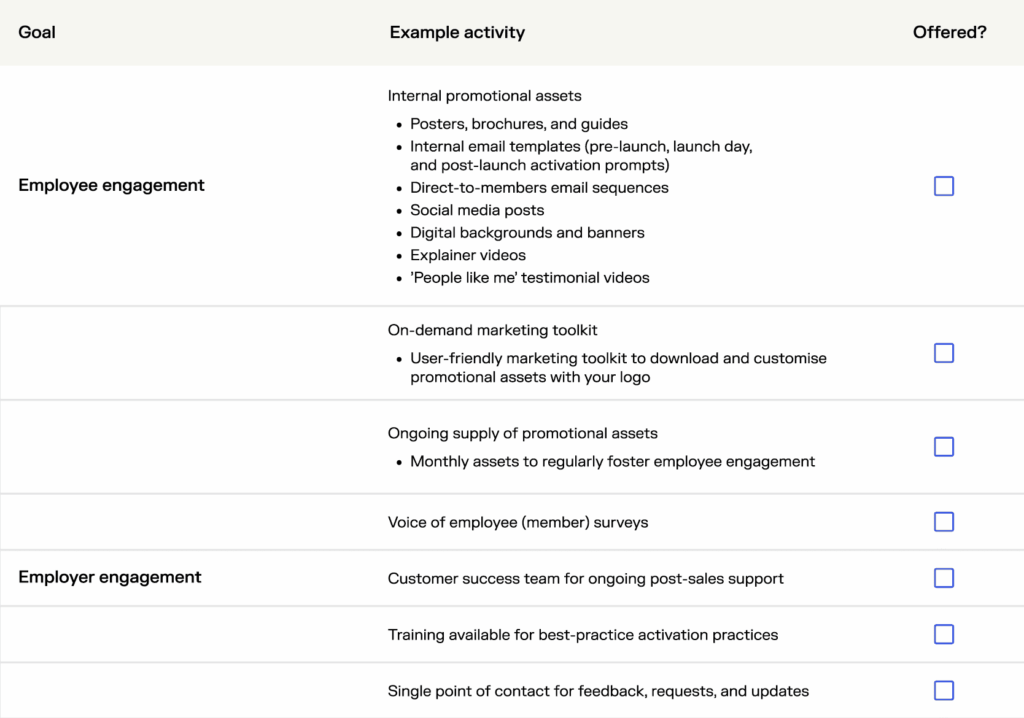
Step eight – Data and insights
Key question: What intelligence is shared to guide business decisions?
For years, employers have complained about the lack of data and insights shared by EAP providers who stood behind the guise of “privacy and confidentiality.”
HR managers – forced to rely only on anecdotal feedback from employees – reported feeling “helpless” and “in the dark” once an employee started using the company’s EAP. The good news: times are changing. Inspired by tech-savvy EAP alternatives like Sonder, providers now share more data and insights to inform critical business decisions – all without compromising employee privacy and confidentiality.
Insider tip
Ask to see sample copies of a provider’s reports and a demo of their live dashboard (if applicable). Note that live dashboards may only be available to larger customers.
“With our prior EAP provider, it would be a handful of support cases, and you didn’t need to do any metrics or reporting because the numbers would be so low that they weren’t worth the paint on a piece of paper.”
Transportation Industry
Example checklist for data and insights
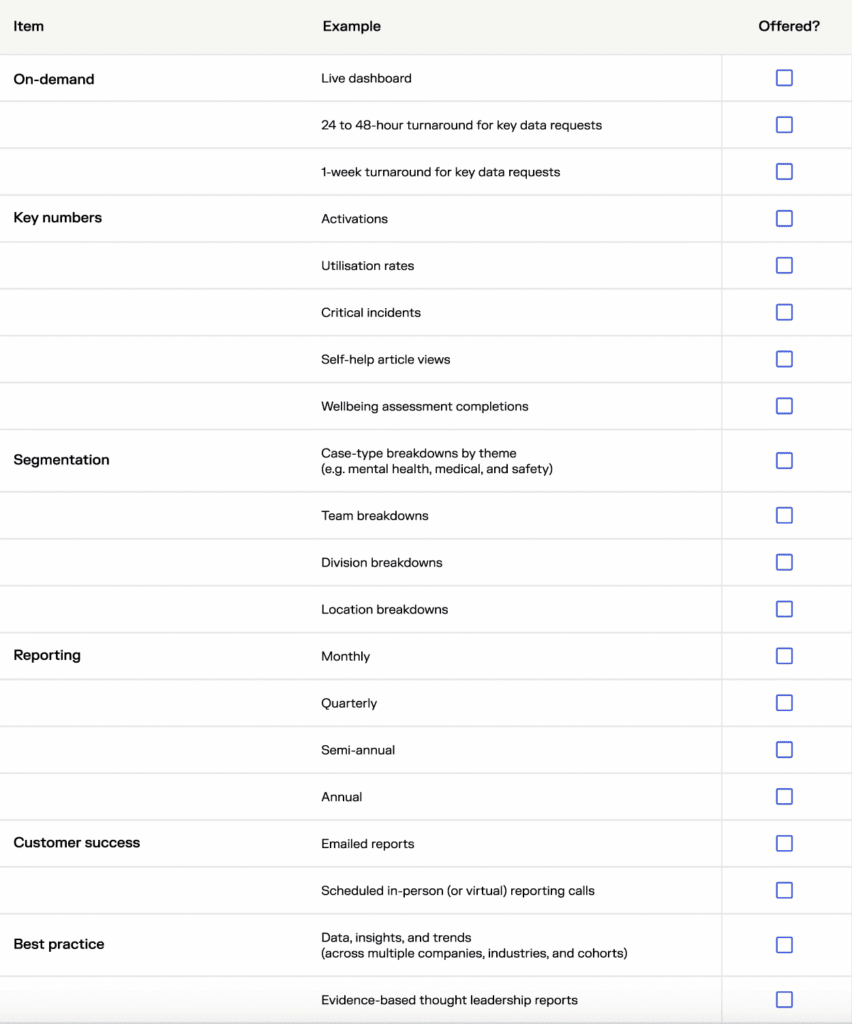
Step nine – Pricing
Key question: Can a fixed-price contract avoid nasty surprises?
It’s hard to put a price on employee health and wellbeing. But, realistically, price is often a key factor in procurement processes for employee wellbeing support. So, how do you evaluate different pricing options and avoid blowing your budget mid-contract?
Try this four-step process:
- Gain executive buy-in on how pricing will influence the final decision and in what circumstances a higher price will be approved.
- Articulate your goal utilisation rate, as well as your expected utilisation rate.
- Run financial modelling scenarios (considering ‘added extras’ and higher-than-expected utilisation), based on different pricing models.
- Compare those results to each other and to the financial risk of not investing in an employee wellbeing strategy.
Insider tip
Most organisations get stung when their usage goes above estimates. To avoid exceeding your budget unexpectedly, always overpredict requirements.
Example pricing models
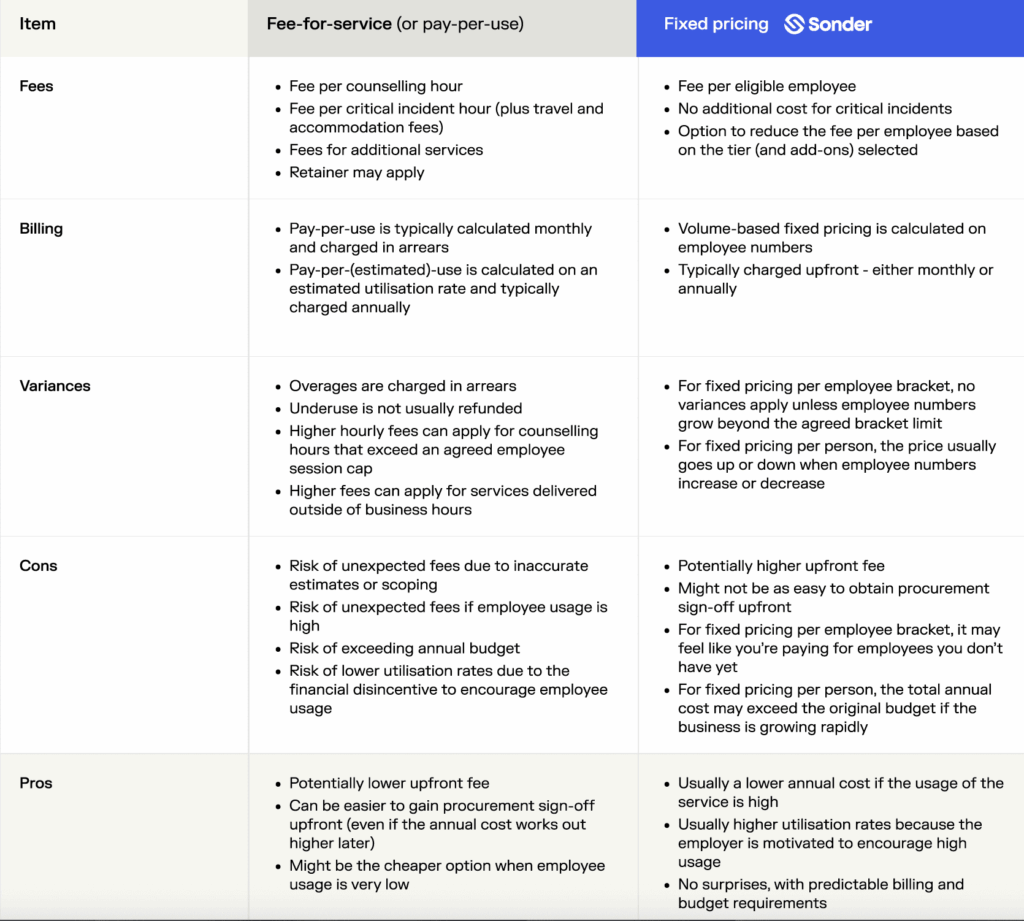
Step ten – Business impact
Key question: How can we assess ROI/ROV?
Historically, when evaluating employee assistance programs, business leaders have focused on return on investment (ROI), and people leaders have focused on the impact on their people.
Today, as business leaders have become more attuned to the flow-on business benefits of a healthy workforce, and people leaders have become more data-savvy, the two camps have aligned on measuring return on value (ROV). This metric considers the program, business, and people impact.
A key element is “putting in place mechanisms to measure performance [which] can enable organisations to achieve desired program impact, improve adoption rates, and enhance decision-making,” says Deloitte.
Insider tip
Check if your provider can help with initial and ongoing ‘voice of employee’ (member) surveys, to establish employee wellbeing benchmark data at various points in time.
Did you know?
- For every £1 spent on an EAP program, UK employers see an average ROI of £10.85
- This has increased from an £8 ROI in 2020/21, and £7.27 in 2019/2020
- The estimated ROI for holistic programmes is even higher when mental health care is combined with other types of support, like those offered in a modern EAP alternative like Sonder
Return on value (ROV)
An ROV assessment is a more comprehensive measure of the success of an employee wellbeing programme than an ROI calculation.
ROV considers both direct and indirect financial benefits to paint a more holistic picture of how an employee wellbeing programme is tracking.
Direct financial benefits:
- Reduced absenteeism
- Fewer payments for substitute workers
- Reduced presenteeism
- Increased productivity
- Reduced workers’ compensation
- Improved return to work rates
- Decreased attrition
- Reduced time taken by colleagues to help employees with poor wellbeing
- Lower lost time injury frequency rates (LTIFR)
Indirect financial benefits:
- Improved employee health and wellbeing
- Enhanced morale and motivation
- Better stress management
- Boosted employee engagement
- Improved quality of individual and team output
- Enhanced employer branding
- Improved loyalty and retention
- Enhanced organisational resilience
Consider an EAP alternative
As you go through the 10-step checklist and consider EAP providers, it’s clear that traditional assistance programmes often fail to address employees’ diverse needs. From low utilisation rates to limited scope of care, many fall short of delivering the outcomes employees and organisations deserve.
That’s where modern EAP alternatives like Sonder shine. Sonder redefines employee support by combining human-led care with innovative technology, creating a comprehensive, 24/7 solution that goes beyond mental health resources. Whether it’s offering mental health and safety assistance, providing preventative care, or integrating seamless digital tools, Sonder ensures employees receive the support they need when they need it most.
Ready to see the impact of a modern EAP alternative? Check out our Insider’s Guide to Employee Assistance Programs and book a free Sonder demo to explore how Sonder can revolutionise employee wellbeing for your organisation.
Note: Data points marked with an asterisk (*) are based on Sonder’s internal dataset, reflecting insights from support cases handled between October 2023 and October 2024.



